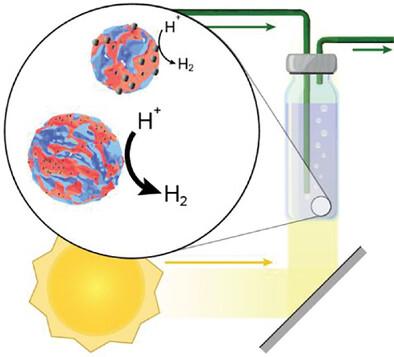当前位置:
X-MOL 学术
›
Adv. Energy Mater.
›
论文详情
Our official English website, www.x-mol.net, welcomes your
feedback! (Note: you will need to create a separate account there.)
A Halted Photodeposition Technique Controls Co‐Catalyst Loading and Morphology on Organic Semiconductor Nanoparticles for Solar H2 Production
Advanced Energy Materials ( IF 24.4 ) Pub Date : 2024-11-20 , DOI: 10.1002/aenm.202403372 Connor R. Firth, Colin Jeanguenat, Viviane Lutz‐Bueno, Victor Boureau, Kevin Sivula
Advanced Energy Materials ( IF 24.4 ) Pub Date : 2024-11-20 , DOI: 10.1002/aenm.202403372 Connor R. Firth, Colin Jeanguenat, Viviane Lutz‐Bueno, Victor Boureau, Kevin Sivula

|
Solar hydrogen production with semiconductor photocatalyst particles typically requires co‐catalysts, but since co‐catalysts are often deposited in situ, the rate of their nucleation/growth and role in parasitic light absorption are not well controlled. Herein a halted photodeposition‐dialysis method is introduced that affords unprecedented control over platinum (Pt) co‐catalyst loading and morphology on bulk heterojunction organic semiconductor photocatalyst nanoparticles. Pt loading and surface distribution are controlled by tuning the initial Pt precursor concentration and photodeposition time followed by removal of unreacted Pt precursor via dialysis. Applying this method with typical Pt deposition conditions gives a max H2 evolution rate of 140 mmol h−1 g−1 (based on semiconductor mass) with only 15.2 wt.% Pt deposited and suggests an optimum loading of <20 wt.% Pt, above which parasitic light absorption decreases the H2 evolution rate. Moreover, a peak H2 evolution >30 mmol h−1 g−1 is achieved with a Pt loading of only 1.01 wt.% by tuning the deposition conditions to favor a more uniform Pt coverage with small clusters and single atoms over larger Pt NPs. This represents a performance more than eight times higher compared to typical Pt photodepositions (based on Pt) and gives critical insights into optimizing performance.
中文翻译:

一种停止光沉积技术控制有机半导体纳米颗粒上的助催化剂负载和形态,用于太阳能 H2 生产
使用半导体光催化剂颗粒生产太阳能氢通常需要助催化剂,但由于助催化剂通常原位沉积,因此它们的成核/生长速率和在寄生光吸收中的作用没有得到很好的控制。本文介绍了一种停止光沉积-渗析方法,该方法对块异质结有机半导体光催化剂纳米颗粒上的铂 (Pt) 助催化剂负载和形态提供了前所未有的控制。通过调整初始 Pt 前体浓度和光沉积时间,然后通过透析去除未反应的 Pt 前体来控制 Pt 负载和表面分布。将这种方法与典型的 Pt 沉积条件应用,最大 H2 析出速率为 140 mmol h-1 g-1(基于半导体质量),仅沉积了 15.2 wt.% Pt,并建议最佳负载为 <20 wt.% Pt,超过该水平寄生光吸收会降低 H2 析出速率。此外,通过调整沉积条件以有利于小簇和单个原子的 Pt 覆盖,而不是较大的 Pt NP,在仅 1.01 wt.% 的 Pt 负载下实现了峰 H2 析出 >30 mmol h-1 g-1。与典型的 Pt 光沉积(基于 Pt)相比,其性能高出 8 倍以上,并为优化性能提供了关键见解。
更新日期:2024-11-20
中文翻译:

一种停止光沉积技术控制有机半导体纳米颗粒上的助催化剂负载和形态,用于太阳能 H2 生产
使用半导体光催化剂颗粒生产太阳能氢通常需要助催化剂,但由于助催化剂通常原位沉积,因此它们的成核/生长速率和在寄生光吸收中的作用没有得到很好的控制。本文介绍了一种停止光沉积-渗析方法,该方法对块异质结有机半导体光催化剂纳米颗粒上的铂 (Pt) 助催化剂负载和形态提供了前所未有的控制。通过调整初始 Pt 前体浓度和光沉积时间,然后通过透析去除未反应的 Pt 前体来控制 Pt 负载和表面分布。将这种方法与典型的 Pt 沉积条件应用,最大 H2 析出速率为 140 mmol h-1 g-1(基于半导体质量),仅沉积了 15.2 wt.% Pt,并建议最佳负载为 <20 wt.% Pt,超过该水平寄生光吸收会降低 H2 析出速率。此外,通过调整沉积条件以有利于小簇和单个原子的 Pt 覆盖,而不是较大的 Pt NP,在仅 1.01 wt.% 的 Pt 负载下实现了峰 H2 析出 >30 mmol h-1 g-1。与典型的 Pt 光沉积(基于 Pt)相比,其性能高出 8 倍以上,并为优化性能提供了关键见解。

































 京公网安备 11010802027423号
京公网安备 11010802027423号